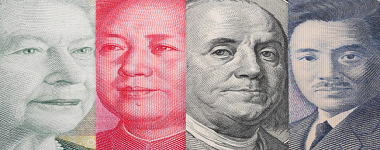by Jim Ritchards, Daily Reckoning
In describing the dynamics of currency wars, I consistently use metaphors such as a tug of war or seesaw. This is to indicate that currency wars are never a one-way bet. Exchange rates go back and forth repeatedly.

The currency war that lasted 1921-1936 is a good example. In 1921, the Germans destroyed their currency in the famous Weimar Republic hyperinflation.
In 1925, France and Belgium devalued their currencies. That made British pounds sterling and the U.S. dollar stronger.
In 1931, the U.K. struck back by devaluing pounds sterling. This put the pressure on France and the U.S.
Then, in 1933, the U.S. devalued the dollar, putting pressure back on the U.K. and even more pressure on France. Finally, in 1936, France and the U.K. both devalued against the dollar again.
This was the infamous sequence of the “beggar thy neighbor” devaluations.
Or consider the history of today’s currency war. We saw a weak Chinese yuan and strong dollar from 2008-2010.
Then in 2011, the U.S. engineered a weak dollar. The Fed’s dollar index actually hit an all-time low in August 2011. At the same time, gold hit an all-time high – no coincidence there.
Next, the Japanese yen was cheapened under Abenomics beginning in December 2012.
By mid-2014, it was time to cheapen the euro, which crashed from $1.30 to $1.05 by January 2015. As a result, the dollar reached a 10-year high by mid-2015.
Then the Fed blinked and started to back away from rate increases, which took the dollar down a notch.
The point is there were no one-way bets. The U.S. dollar got stronger from 1921-1933. Then it weakened from 1933-36 and got stronger again after 1936. The dollar was also strong in 2010, weak in 2011 and strong again in 2015. The same analysis applies to the other major currencies.
That’s how currency wars play out.
The key to investing during currency wars is to focus on the underlying dynamics and stay nimble.

